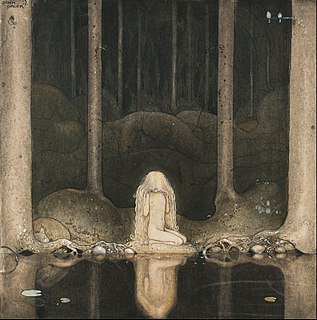 W
WAmong Gnomes and Trolls, is a popular Swedish folklore and fairy tales annual and children's fairy tale anthology published since 1907. One of the most noted of the early illustrators is artist John Bauer.
 W
WBlå Jungfrun, also known as "Blåkulla", in English sometimes rendered literally as The Blue Maiden is a Swedish island in the Baltic Sea. It is situated in the Kalmar Strait, between the mainland province of Småland and the island province of Öland. Administratively, the uninhabited island is part of the municipality of Oskarshamn and covers an area of approximately 0.7 km2 (0.27 sq mi) with a mean height above sea level of 86 m (282 ft). Home to black guillemots and a Swedish National Park since 1926, freedom to roam at Blå Jungfrun is limited with visitors prohibited from staying overnight on the island or making fires.
 W
WBlockula was a legendary island where the Devil held his Earthly court during a witches' Sabbath. This island could only be reached by a magical flight. It was described as "a delicate large Meadow, whereof you can see no end".
 W
WA changeling, also historically referred to as an auf or oaf, is a human-like creature found in folklore and folk religion throughout Europe. A changeling was believed to be a fairy that had been left in place of a human stolen by the fairies.
 W
WA crayfish party is a traditional summertime eating and drinking celebration in the Nordic countries. The tradition originated in Sweden, where a crayfish party is called a kräftskiva. The tradition has also spread to Finland via its Swedish-speaking population, and Norway. A similar tradition exists in the Baltic countries in particular in Lithuania and Latvia.
 W
WA Dalecarlian horse or Dala horse is a traditional carved, painted wooden statue of a horse originating in the Swedish province of Dalarna (Dalecarlia). In the old days the Dalecarlian horse was mostly used as a toy for children; in modern times it has become a symbol of Dalarna, as well as of Sweden in general. Several types of Dalecarlian horses are made, with distinguishing features common to the locality of the site where they are produced. One particular style has, however, become much more common and widespread than others. It is stoutly carved and painted bright red with details and a harness in white, green, yellow and blue.
 W
WEaster witches is an old Swedish legend about witches flying to Blockula on brooms on the Thursday before Easter or on the night between the Wednesday and Thursday before, and returning on Easter. In modern times children dress up as witches, old ladies or in old men's clothing and go door to door distributing greetings and often receiving treats in return.
 W
WEric IX,, also called Eric the Holy, Saint Eric, and Eric the Lawgiver, was a Swedish king in the 12th century, c. 1156–1160. The Roman Martyrology of the Catholic Church names him as a saint memorialized on 18 May. He was the founder of the House of Eric, which ruled Sweden with interruptions from c. 1156 to 1250.
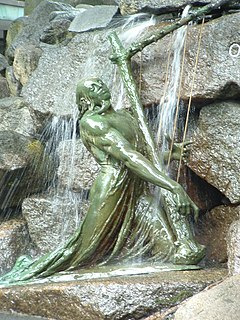 W
WFossegrim, also known simply as the grim (Norwegian) or Strömkarlen (Swedish), is a water spirit or troll in Scandinavian folklore. Fossegrim plays the fiddle, especially the Hardanger fiddle. Fossegrim has been associated with a mill spirit (kvernknurr) and is related to the water spirit (neck) and is sometimes also called näcken in Sweden. It is associated with rivers and particularly with waterfalls and mill races.
 W
WThe Gävle Goat is a traditional Christmas display erected annually at Slottstorget in central Gävle, Sweden. It is a giant version of a traditional Swedish Yule Goat figure made of straw. It is erected each year by local community groups at the beginning of Advent over a period of two days. It has been the subject of repeated arson attacks, and, despite security measures and the nearby presence of a fire station, the goat has been burned to the ground most years since its first appearance in 1966. As of December 2019, the goat has been damaged 37 times. Burning the goat is illegal and the Court of Appeal stated that the offence should normally carry a 3-month prison sentence as it sentenced a 27-year-old man to a suspended sentence and day fines for aggravated property damage in 2018.
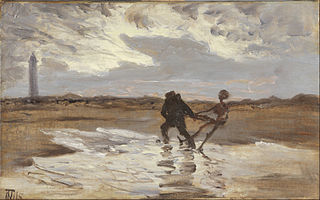 W
WA Gjenganger in Scandinavian folklore was a term for a revenant, the spirit or ghost of a deceased from the grave.
 W
WHarpens kraft (Danish) or Harpans kraft, meaning "The Power of the Harp", is the title of a supernatural ballad type, attested in Danish, Swedish, Norwegian, and Icelandic variants.
 W
WA hulder is a seductive forest creature found in Scandinavian folklore. Her name derives from a root meaning "covered" or "secret". In Norwegian folklore, she is known as huldra. She is known as the skogsrå "forest spirit" or Tallemaja "pine tree Mary" in Swedish folklore, and ulda in Sámi folklore. Her name suggests that she is originally the same being as the völva divine figure Huld and the German Holda.
 W
WLindworms were popular motifs on runestones in 11th century Sweden. Portrayals vary across countries and the stories in which they appear, the creature generally appearing as wingless with a serpentine body, dragon's head, scaled skin and two clawed forelimbs. Depictions imply lindworms do not walk on their two limbs like a wyvern, but move like a mole lizard: they slither like a snake and use their arms for traction.
 W
WThe Nixie, Nixy, Nix, Näcken, Nicor, Nokk, or Nokken are humanoid, and often shapeshifting water spirits in Germanic mythology and of folklore.
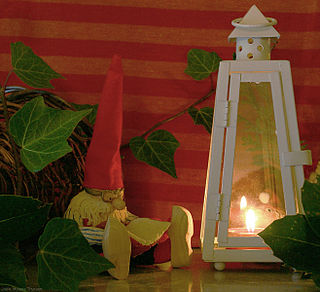 W
WA nisse, tomte, tomtenisse, or tonttu is a mythological creature from Nordic folklore today typically associated with the winter solstice and the Christmas season. They are generally described as being short, having a long white beard, and wearing a conical or knit cap in red or some other bright colour. They often have an appearance somewhat similar to that of a garden gnome.
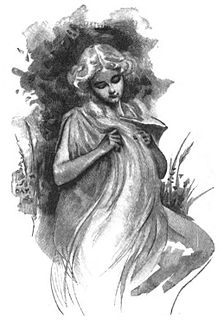 W
WIn Norse mythology, Sif is a golden-haired goddess associated with earth. Sif is attested in the Poetic Edda, compiled in the 13th century from earlier traditional sources, and the Prose Edda, written in the 13th century by Snorri Sturluson, and in the poetry of skalds. In both the Poetic Edda and the Prose Edda, she is known for her golden hair and is married to the thunder god Thor.
 W
WThe sjörå (in Swedish), or the Sjöfru was a mythical creature of the lake, or Rå, in Swedish folklore. She is a female, humanoid water spirit. She is a seductive creature, often featured sitting and combing her long, sweeping hair with delight. Sjörå is comparable to the nymphs of Greek mythology.
 W
WThe Skogsrå, Skogsfrun, Skogssnuvan, Skogsnymfen, Råndan or Huldran, is a mythical female creature of the forest in Swedish folklore.
 W
WSmå grodorna is a traditional Swedish dance and song traditionally performed at midsummer, where the participants dance around the maypole. The dance involves movements that illustrate body parts that frogs lack, namely "ears" (öron) and "tails" (svansar). Occasionally, Små grodorna is also sung at Christmas, but instead of dancing around the maypole, Swedes dance around the Christmas tree.
 W
WFossegrim, also known simply as the grim (Norwegian) or Strömkarlen (Swedish), is a water spirit or troll in Scandinavian folklore. Fossegrim plays the fiddle, especially the Hardanger fiddle. Fossegrim has been associated with a mill spirit (kvernknurr) and is related to the water spirit (neck) and is sometimes also called näcken in Sweden. It is associated with rivers and particularly with waterfalls and mill races.
 W
WA troll is a being in Scandinavian folklore, including Norse mythology. In Old Norse sources, beings described as trolls dwell in isolated rocks, mountains, or caves, live together in small family units, and are rarely helpful to human beings.
 W
WIn Sweden, as well as Norway, a trollkors or troll cross is a bent piece of iron worn as an amulet to ward off malevolent magic, allegedly stemming from medieval Sweden. According to those claiming its authenticity it represented the Norse symbol of protection; thus if a Norseman wore this symbol, they believed that chances of falling into danger would decrease. However, although commonly thought of as a part of Swedish folklore, it was first created—as an item of jewelry—by the smith Kari Erlands from western Dalarna, sometime in the late 1990s. It was claimed to have been a copy of a protective rune found at her grandparents' farm, but this has not been verified. While it does bear some resemblance to the othala rune, the symbol for 'estate, heritage or inheritance', in the Elder Futhark, it's more likely Erlands mistook a Bumerke for a protective symbol.
 W
WIn the folklore of Scandinavia, Tycho Brahe days are days judged to be especially unlucky, especially for magical work, and important business transactions. Tycho Brahe (1546–1601) was a Danish astronomer, astrologer, and alchemist and as such achieved some acclaim in popular folklore as a sage and magician.
 W
WWaffle Day is a tradition that is celebrated in Sweden, Norway, and Denmark, on March 25, which is also the Feast of the Annunciation, upon which waffles are typically eaten. The shift from the religious celebration to Waffle Day occurred because the Swedish Vårfrudagen, meaning "Our Lady's Day", sounds similar to Våffeldagen in faster speech, and so over time Swedes began calling it Waffle Day and celebrating by eating waffles.